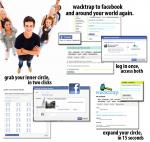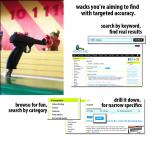What’s your story?
Share and find customer experiences
Connect with the people behind them
Wacktrap is
feedback made social
Trending Content
Top Wack Ways Get Angry Customers Back Down Video
by editor

Customer service training video "Top 6 Ways to Get an Angry Customer to Back Down" as likely to inspire consumer ire-if customer service sucks, just get the pack o' angry customers to 'back down'.
Since a company certainly can't command customers to 'Sit', this training video seems instead aimed at customer service representatives getting those angry customers (the whole pack of 'em) to 'back down'. The training title says it all, so this 7-minute video tutorial is not to be confused with the company or its customer service representatives actually providing better and more fruitful customer service: no, the goal is to get that pack of angry customers to back down, then call it day. Apparently, if you can get customers to 'back down', mission accomplished.
This customer service training video is good, good, good-wack enough to the point of being great. Especially if you're a ticked-off consumer that's just gotten of the phone with customer service with pretty much any company, and in need of a long laugh. Video training includes the promise of "six, field-tested strategies for responding to anger," though it remains unclear as to what field these supposed training strategies were tested on. One thing seems clear: no Fortune 500 companies were harmed in the making of this film.
Title, alone, of this self-help (or not help) video is enough to make any logical person, customer or not, question final destination. That title certainly grabs attention. After all, it's not training for the "Top 6 Ways to Provide Better Customer Service to an Angry Customer" or "Top 6 Ways to Get an Angry Customer to Calm Down". Nope, it's "Top 6 Ways to Get an Angry Customer to Back Down"-and that title includes two vital keywords: 'Back Down'. Maybe that's the key clue: 'Back Down'. Improving customer service doesn't seem to be the goal of this training tutorial, so neither consumers nor companies should be confused.
Step two of training includes "Kill them [the customers] softly with diplomacy". Wow, there's a lot of ways to kill, but killing them softly isn't typically one of the norms. Including 'kill' and 'customers' in the same concept of course seems a bit odd of a correlation. But, hey, whatever works. Wait, wasn't that "killing me softly"? Well, it doesn't matter, what's relevant got to do with it anyway? Apparently 'killing them softly' has reared its ugly (and, here it seems, semi-volatile) head. At least in this customer service training video.
Step 3: to get an angry customer to back down, this training tutorial claims you've [the customer service rep] got to 'Go Into Computer Mode'. That's right, all you customer service reps better listen up out there: be sure to 'act like a computer' with (alread) angry customers and be sure to 'speak generally, without emotion'. This advice is topped off with what appears to be a royalty-free image of a man wearing headphones, including the appearance that he has just been sedated and is staring blindly into the camera. Yeah, about on par with a mug shot, just add headphones. Headphones automatically portray a professional image, we all know that. Wearing headphones, that guy must be a 'business' person, since he appears so 'professional'.
As anyone knows, customer or rep, a customer (angry or not) certainly appreciates when the representative on that phone line acts like a robot or unthinking device. After all, we don't get enough of this in society-customers definitely want a computer-like reception when they take the time to call in to a company to talk with a live person. It's amazing this tip doesn't top the list for all good customer service lists-how the tip has gone so unnoticed is unfathomable.
This training tutorial promises that employment of "this computer-mode response" by customer service representatives "reflects, diffuses, and disarms angry customers." Hmmm...that's odd: put most customers with an IQ above 80, and on the receiving end of any customer service representative whom "acts like a computer," and it seems far more likely to inspire ire than result in a sudden halt in angry emotions.
It seems the tutorial's creator is a bit biased in the field of customer service. She expresses the idea clearly, that angry customers aren't actually looking to have their problems with a company resolved, that instead those customers are looking for reason to be angry and continue holding that anger-with any misstep by customer service representatives as perceived reason to fan the flames. If this perception holds any ounce of truth, then perhaps the customer service rep is receiving calls from customers whom have nothing else to do in life, or are simply bored.
It's hard to believe that most customers simply don't want to find a way for the company to correct the problem or their service account-how stupid for customers, or companies, to think that fixing the problem typically goes a long way in reducing anger. Strangely, when a problem is corrected, there's nothing more to feel angry about. But that logic holds no water here: according to this (seemingly-former customer service rep): steps toward getting an angry customer to back down include simply telling the customer what he or she wants to hear. The customer service rep is supposed to (carefully) absorb blame or apologize for company error (but not in a way that seems to put the company in risk of liability, or that truly states the company is directly at fault), regardless of whose fault the problem is. The training tutorial doesn't go any further, like addressing actually fixing the problem-just apologizing for the issue. That's right, almost forgot: the training video already said that angry customers supposedly don't care about the problem actually being resolved, only about being angry. So that problem doesn't need to be fixed. Duh.
Training video tutorial highlights include Number 4, wherein included instructions tell customer service representatives to 'give this [training method] a shot': ask the angry customer "Have I done something personally to upset you." Since every logical person knows that a customer only becomes more relaxed when a customer service agent now refuses to address a company problem through instead posing the issue on a personal level, this suggestion of course makes perfect sense. That way the customer now feels as if he or she is defending themselves, from some supposed wrong they have inflicted upon the customer service rep, so that the customer can focus on getting the real problem fixed.
Training states "of course you know you [the customer service rep] haven't done anything to upset the customer" (that is, until you, the custome service rep, just asked the above question). Training claims that "this question is [intended] to force the angry customer to think about his (apparently there are no angry females that call telephone customer service, just males) behavior." The other result, of course, is that the customer is now focusing on just how much he or she truly hates the company and its snarky representatives.
According to training, "this question is enough to get the 'ballistic' customer to shift from the right brain to the left brain." Apparently, now the customer being addressed in this video is no longer just angry, but rather has moved into the 'ballistic' zone. The customer might in fact be ballistic at this point, particularly after the perception of an antagonistic customer service representative. Training says this question allows the (newly-ballistic) customer to calm down so that "he can begin to listen and rationalize." It's unknown whether what the customer is rationalizing includes methods of retaliation.
Another highlight is near training tutorial end. Sad to say, the video is coming to an end. Training says that a customer service rep employing use of 'empathy' comes as "a shock factor" to the customer (and this is supposed to be a good thing, just to clarify). The 'shock factor' statement may well be true. After a customer service representative has so intuitively used the defense-inducing question of, "Have I done something personally to upset you?," it does seem that immediate introduction of empathy probably would be a shock to consumers.
The same method is probably equally effective in creating a confusion factor for the customer, about on par with Alice and "Through the Looking Glass". Let's see, first the customer service rep is supposed to ask if the rep has done anything 'personally' to the customer, and then that service rep is supposed to empathize with the customer. Are these customer service methods (used in conjunction with one another) supposed to make the customer feel like they're on some drug, or that they've just entered an alternate universe?
Apparently the display of empathy by customer service is so powerful over a consumer, it's simple employment can nearly knock the consumer into a semi-conscious state where they're no longer harmful. Kind of like rolling a shark over onto its back in water, so that it's in a daze, no longer able or wanting to bite the hand around its tail: the tutorial claims that "When the customer is stunned into silence [through use of empathy], you [the customer service representative] get in the driver's seat." It's unclear where that customer service rep is now driving to (we know it's not to fix any customer problem, that much is clear). It seems unlikely that rep is driving off the path of anger, at least not with the customer as passenger.
The training video ends with the promise that "the next time you find yourself the target of verbal abuse," by following these service tips "you'll be far more effective." It's not stated whether that effectiveness includes inspiring customer hatred toward a company. It is odd that 'verbal abuse' wasn't included tutorial title. Despite the fact that, at no point during the tutorial was there mention that the faux angry customer who is learning to 'back down' was ever known to employ 'verbal abuse', there seems to be a lot of reference to the concept that telephone customer service representatives are being abused by consumers. Perhaps the tutorial's creator felt that, at some point, she was the target of verbal abuse in some previous or current career-since the inclusion of 'verbal abuse' is so frequently referenced.
Appropriately it seems, the customer service video tutorial ends with the parting message "Good luck" across the screen. And that parting tutorial message seems on target, since any customer service rep that follows this video advice may well be in need of good luck.
Future tutorial titles, hoped for, could include "Top 6 Ways to Make an Angry Customer Even Angrier" or "Top 6 Ways to Make an Angry Customer Ballistic". Unfortunately, not included in the tutorial is the list of Fortune 500 companies that employ these customer service methods. Also unfortunate is that the training video creator doesn't list any customer service employment where he (or she) might be involved. "Back down" you angry customer, "back down".
SPEED UP YOUR ONLINE GROWTH
How To Wack
Take the Tour
Click on any image to start










